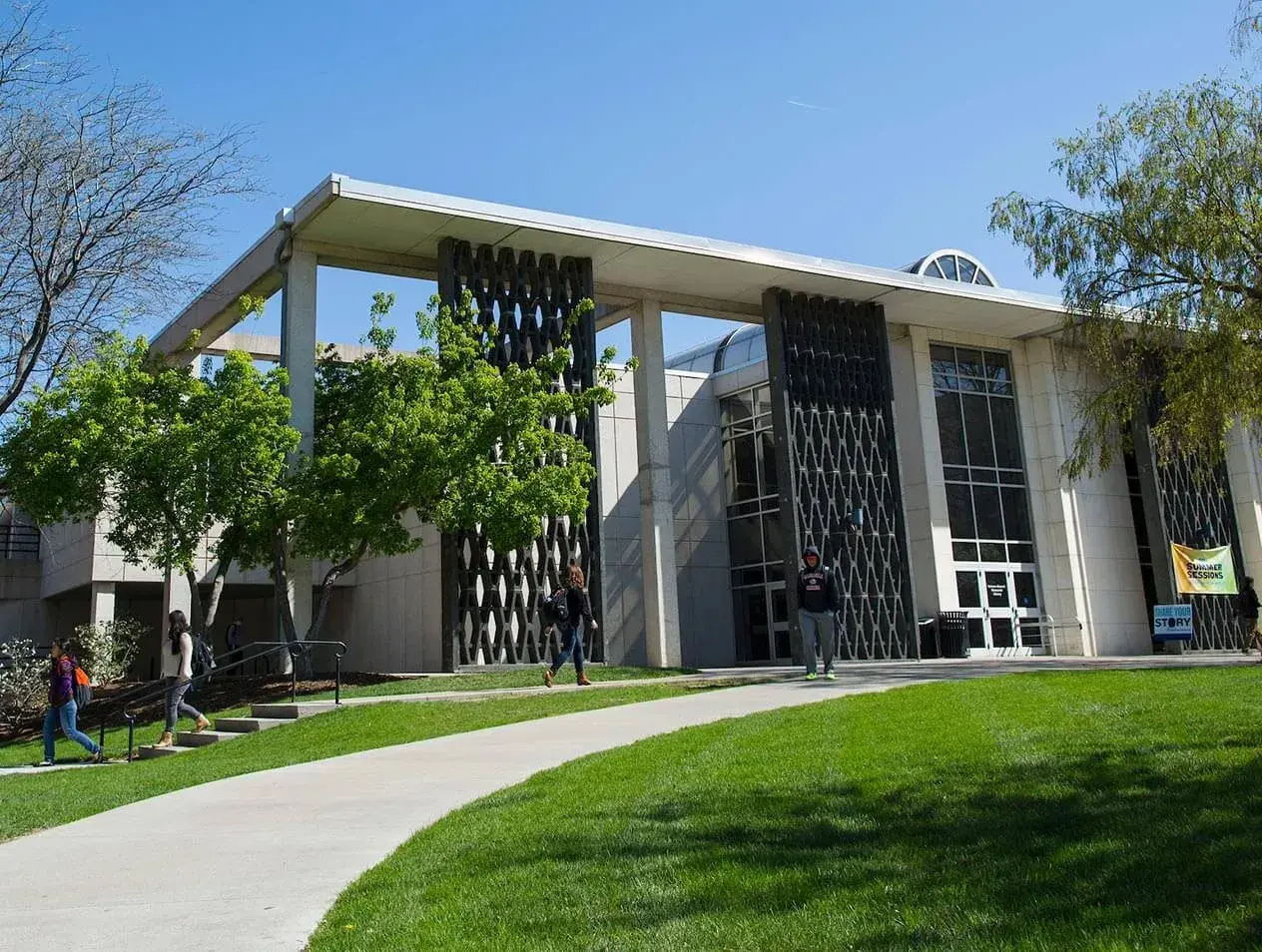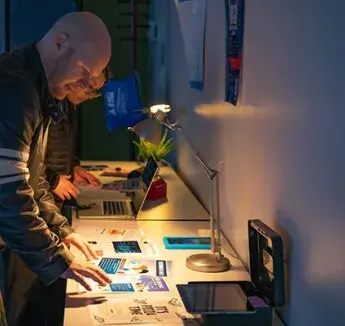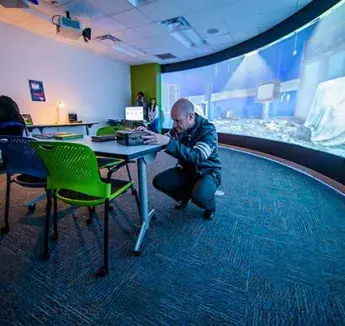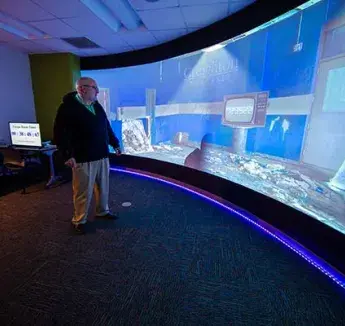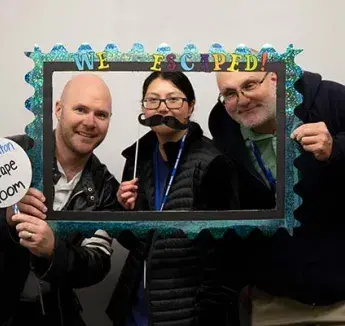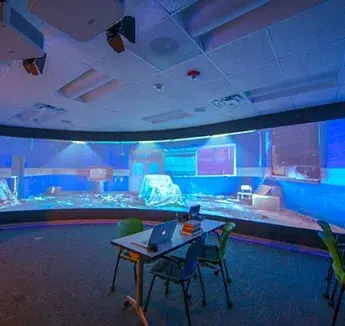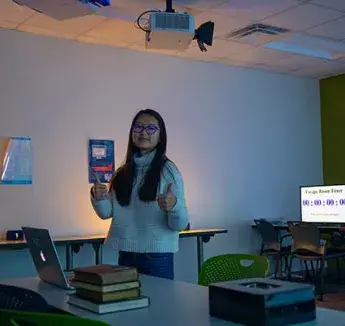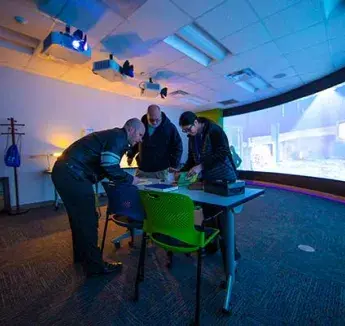
Emerging Technologies Projects
Emerging technologies projects can be initiatied through different avenues,including:
- Contacting one of our program leads
- Projects led by University Libraries' staff to test the viability and value of new technologies to the University
- Partnerships with university faculty and staff to develop digital scholarship, digital humanities projects, or data-rich projects
Learn More About Emerging Technologies Projects
Augmented Reality and Emerging Technologies
Augmented reality (AR) is overlaying information in the physical world. In this way, it "augments" the real world.
University Libraries has explored several ways in which AR might be used in education. This has included the creation of posters that contain augmented reality in the form of text, videos, and audio. The potential for expanded use of augmented reality in the future is significant. As such, University Libraries will continue to explore the possibilities.
The Emerging Technologies met with faculty in the College of Nursing in 2018 to discuss the possibility of using augmented reality with posters. After understanding how it might work, the faculty wanted to use an AR poster for student assessment in patient care. Two posters were created, scripts were written, and local talent used to create augmented reality experiences for nursing students. In this case, students were introduced to two fictional patients, listened to “relatives” (AR video), were provided with patients’ stats from nurses (AR video), and worked in groups to determine the next steps. This was done by pointing a device at one of several target images to trigger the videos. Students work in groups to determine the next steps of patient treatment based on the information they have obtained from the AR poster.

After this successful endeavor into the use of AR for student learning, nursing faculty have expanded the use to an AR poster for a mental health unit. This provides a unique way to assess adolescent mental health conditions while protecting students from potentially unpredictable patients. In addition, this program has expanded to using AR posters for leadership training.
Unity was used to create these experiences. Apps for these experiences are available in the Apple and Android app stores. When paired with the available posters, students can interact with these experiences anywhere, including at our Phoenix campus.
Sue Calef, PhD, Assistant Professor in Theology, teaches a course entitled, “Bible, Spirituality, and American Public Life.” It is designated as a technology course. As such, she came to the Emerging Technologies and Reinert Library in pursuit of innovative ideas for her students to experience. It was recommended that they use augmented reality to create interactive posters for the final course project. We introduced Dr. Calef to an augmented reality tool called Zapworks and provided licenses to her students. She demonstrated how it worked and provided training for her students. The students created posters with target images that played videos, slide shows, and text that further explained the themed topic of each poster.
During February 2020, students placed these posters on the interior windows of the Reinert Library with instructions on how to download the free app (Zappar) and explore the information through augmented reality. These posters were displayed for the Creighton community and visitors to explore.


Escape Rooms
Our First Escape Room
In the fall of 2019, we were trying to create an experience that would help students and others learn more about cybersecurity. It needed to be fun, but also educational. The idea of an escape room came up. Our interns jumped at the opportunity to create one. The setup was in the Reinert Library C.A.V.E. That allowed us to create an amazing environment with the curved wall and three projectors. Since it was near the end of October, the Halloween theme seemed to fit both the time of year and the topic. Groups went through the escape room solving a variety of challenges associated with cybersecurity. Most were able to escape.
The setup was such that most of the props used fit into a plastic box. That and the video background made it very easy to store. It served as a model for future escape rooms. The Canon team was the first group to take on the challenge.
This project was done in collaboration with the IT Communications Team.
With the success of the October Cyber Security Escape Room, the University Libraries created a version for the Technology Test Kitchen that took place in February 2020. This shortened 15-minute escape room focused on phishing and was available to students, faculty, and staff.
The Twilight Zone themed escape room featured an invitation to a Billy Bluejay birthday party. Participants were asked to help in planning the party and had to accomplish a number of tasks to do so. With the help of a phishing poster, participants had to pass a quiz. From there, they were taken to a “fake” website where they made invitations to send out. Throughout this process, they compiled information that might put them at risk, found messages on balloons, determined the difference between real and phishing emails, and used augmented reality to open a video.



Creating an escape room to educate students on cybersecurity risks in the midst of the COVID-19 pandemic was a challenge. After discussion and research, it was decided that in collaboration with IT Communications, the University Libraries would develop a virtual escape room.
A 3D animated, lip-synced avatar was created to serve as the guide. Interns recorded the avatar’s voice, took 360-degree photos of a Creighton dorm room, and created a series of challenges that participants needed to complete to escape the virtual world.
Those taking part in the activity worked in groups through Zoom to complete the adventure.
This type of activity not only works for a cyber security escape room but serves as a model for possible course activities based on other topics.






 Amazon Alexa Skills
Amazon Alexa Skills

As prospective students are led across campus by student tour guides, it becomes a challenge for the tour guides to know what is currently happening in a variety of areas, including University Libraries. One way to improve this is to have an updated audio tour ready for tour guides and others. The University Libraries tackled this challenge. With an Amazon Alexa business account, we were able to create our own skills and determine what other skills are available for that account.
An Echo Dot was placed in the ceiling outside of University Libraries. A tour guide (or anyone else) can ask the following, "Computer (replacing the default Alexa wake word), run guide" Alexa will ask what you would like to know. The University Libraries tour is one of the options that provides updated information on the lab. In addition, students can use the Alexa map skills to find other locations on campus.
This test was done to help determine whether the use of this technology would be helpful at other locations on campus.
The Kingfisher Institute was established to promote the complementary reinforcement of liberal arts with professional education. It was inspired by the poem “As Kingfishers Catch Fire” by Gerard Manley Hopkins. Father Hendrickson used this poem in his inaugural presidential address.
The University Libraries was asked to create a poster for the Kingfisher Institute. Chad Brocker created the one pictured below that was selected for display in the glass-walled Kingfisher room.


A 24-hour atrium in the Reinert building across from the main entrance into the library is heavily used by students for study, collaboration, and having a snack. It needed an update. The old carpet, whiteboard, and furniture were removed. New carpeting was installed along with better lighting and fresh paint. Since the library was getting new furniture, some of the older furniture that was no longer needed in the library, but still popular with the students, was moved into the atrium.
Things were looking much better, but the back of the atrium has a large, curved wall that was totally blank and in definite need of a creative solution. Ryan Cameron suggested that large mosaic images that represent student global engagement would be a great addition. Chad Brocker took up the challenge and created three images composed of thousands of small photos representing these student activities. The result was a greatly improved look and experience for students using the area.




Faculty Resources
Many projects have been accomplished in association with Creighton University faculty. As the University Libraries move forward, more of our projects will include those types of collaborations. When a request is made, University Libraries first consult with that faculty member to determine whether or not the project is a good match for the tools and skills available within the University Libraries. In addition, the potential benefit to Creighton University and students is considered. University Libraries is an innovation space, and as such, we will often try things with which we have had no previous experience. This involves considerable research and trial and error but can lead to new discoveries.
If you are interested in exploring a collaboration with University Libraries, please contact us at 402.280.3646. We look forward to working with you
The University Libraries’ Technology Eruditio procureto Program provides an opportunity for faculty to learn the foundations of our online world through hands-on learning. This program is a semester-long commitment that meets weekly in the style of a “reading group.” During this reading group, participants learn the foundations of web development using The Odin Project as our guide. Here, we will learn how the internet works, how to tame the command line, how to work with Git, learn the basics of HTML and CSS, Flexbox, and JavaScript. Faculty will not need to purchase anything, and all skills learned are part of the open-source movement in web development.
Faculty who participate in this program will receive a FREE Samsung Galaxy Tablet.
Faculty and staff from the Omaha and Phoenix Campuses are welcome to apply.
When: Weekly during the Fall semester
Where: University Libraries, Reinert-Alumni Library, First Floor, Suite L06
Apply here:
https://blueq.co1.qualtrics.com/jfe/form/SV_9AVU5tRtRXKJSuO
For questions and further information, please contact us.
Converting a course to be online or even to a hybrid version can be challenging. Fortunately, Creighton has a number of tools that can help. Be sure to visit the Teaching and Learning Center for assistance and faculty development. The University Libraries assisted with creating a public (no need to sign in) Teaching Resources course in BlueLine. It is available at: https://blueline.instructure.com/courses/1163855. Included in those resources are links to faculty and student guides, Videos in BlueLine, Other BlueLine Tools, and BlueCast Resources
Data Visualization and/ or Analysis:
Start Here: https://www.tableau.com/sites/default/files/media/which_chart_v6_final_0.pdf
Tableau (public version is free): https://public.tableau.com/en-us/s/
Excel (with pivot tables, Excel is the industry standard): https://www.excel-easy.com/data-analysis/pivot-tables.html
https://openrefine.org/ (For cleaning data)
Mapping:
https://support.google.com/fusiontables/answer/2571232?hl=en
Virtual Worlds

As we are challenged with finding creative ways to engage students, University Libraries has been working on a variety of possibilities. Implementing virtual worlds into course curricula provides one innovative way for students and faculty to communicate and share learning experiences in real-time. Our goal was to find a solution that is reliable, easy to use, cost-effective, and that will work in virtual reality.
One solution that has been extensively researched in University Libraries is Sansar, a 3D virtual, social platform, where faculty and students can meet in real-time. It provides an immersive environment for self-expression, exploration, and live events where players can shape the narrative as it unfolds. After testing multiple solutions, it became clear that the Sansar game engine covered all requirements. Student and faculty access to the platform is free. Programming capabilities are easy to use, and new features are released weekly.
The University Libraries are producing several virtual worlds including a new teaching environment for faculty. Custom programming will be available for courses. Participants create a 3D avatar in Sansar and are then able to visit a variety of locations, including Creighton "worlds."
One of the "worlds" created in Sansar is known as the "Creighton Commons." This is a location not only where students and faculty may meet, but also where prospective students can learn more about Creighton University.




Fr. Greg Carlson, SJ, has a passion for fables. Creighton is fortunate to host this collection that includes 8200 books and 4000 related objects (Aesop’s Artifacts). One of the challenges is to make this collection available for others to enjoy. Chad has created an Aesop’s Fables Museum in Sansar to display a number of the artifacts from the fables collection (using the photogrammetry technique with Canon cameras). The collection will eventually include audio files to describe displays and links to PDF files of public domain fables.
With Fr. Carlson’s guidance, the virtual museum has been greatly expanded to include a large variety of artifacts. This experience is publicly available in Sansar and is a unique way for visitors from around the world to view the collection. Those visitors can look at virtual items and pick them up. This may all be done using virtual reality headsets or viewing on a computer. In addition, it serves as a model for other collections. Screenshots for parts of the museum are shown below.




Chad Brocker and his student interns collaborated with a former instructor in the Heider College of Business, to convert an onsite activity into an online experience for MBA students. The onsite activity involved groups of students working to build bridges between tables using Legos and other building materials. The activity cultivates essential project management skills including collaboration. With the courses moving online, the challenge for the University Libraries was to come up with an alternative, but engaging activity that would help students improve on these same skills.
Sansar was chosen as the platform for this activity. Three Sansar “worlds” were created by Chad: Jurassic World, Medieval World, and Future World. Students use virtual reality technology to explore their world, collaborate in teams, and improve their communication skills to complete the mission by assembling pieces of a teleporter that would allow them to travel between worlds.
The project can be modified and used by others to promote these and other skills.



This platform and the worlds that are and can be created open new options for student/student, student/professor, and other groups to communicate, collaborate, and learn. This can be especially advantageous when meetings are at a distance.

Many University Libraries projects would not be possible without the tremendous partnership Creighton University shares with Canon Solutions America. Since day one, students have benefited from unparalleled project experience working in science, technology, the arts and math (STEAM) areas. This is largely thanks to the financial, project, and mentorship support provided by Canon.
Being uniquely suited as a research accelerator, the University Libraries shares a common spirit and passion for creating new student learning opportunities, promoting STEAM careers in underrepresented communities, and solving “wicked” world-wide problems with Canon Solutions America.
Canon has offered us collaboration opportunities as well as the chance to learn more about photography and videography. As such, the University Libraries explores Canon equipment to meet a number of challenges.
One of the collaboration opportunities was to use a Canon camera API (CCAPI) for its ease of use and benefits it may have over the onboard camera controls. The camera being used was the Canon Powershot SX70 with 20.3MP, 65x optical zoom, and 4K video. The project was to determine how the combination might be used for photogrammetry.
Photogrammetry is the science of making measurements from photographs. The input to photogrammetry is photographs, and the output is typically a map, a drawing, a measurement, or a 3D model of some real-world object or scene. Many of the maps we use today are created with photogrammetry and photographs taken from aircraft.
For this project, multiple photos were taken around an object using the Canon API to control the camera. The photographs were stitched together and cleaned up to create 3D images that could be used in virtual worlds. This project worked out very well and photogrammetry has been used for a number of projects, including creating objects for virtual worlds. A big advantage is that using photogrammetry is much quicker than the development of those same objects from scratch using 3D drawing platforms such as Maya.

The result (below)
You may use your mouse to move the 3D object around in the viewer.
Other work in photography has included exploring the camera and lens combinations that work best for a variety of photos. This includes macro photography, sports photography, landscape photography, and portrait photography. Additionally, we are looking into astrophotography opportunities.




In addition to macro photography, you can also do microphotography. One way of doing this is by attaching a camera through an adapter to a microscope. We used the Canon M6 Mark II for this. As a smaller mirrorless camera, it worked extremely well.


Here are some of the photos taken of microscope slides using the camera/microscope setup as shown above.


Project Photo 63:

You may also use a phone adapter with a microscope. One of the ocular lenses is replaced with the one for the adapter as shown in the images below.

The photos below were taken with an iPhone 11 Pro using the phone adapter for the microscope. You may click on an image to view a larger image. Gallery



Another area we are exploring is phone photography. Most of us have a smartphone with us at all times. Many of these phones have cameras - some quite good. The purpose of this project was to provide guidelines for photography, in general, and then more information on phone photography, specifically. This includes how to take photos, phone settings, available lenses and filters, and phone or tablet apps that may be used for editing. Many of the things that we learn about phone photography may be applied when using the higher-end Canon cameras.
A course was created with information on phone photography. It includes videos and information on how to use some of the editing apps that are available. The course is available at: https://blueline.instructure.com/courses/1168274
Digital Humanities Projects
University Libraries have recently expanded digital humanities, digital scholarship, and other digital projects into its repertoire. Here are some of the areas that the University Libraries have expertise in:
- network analysis
- database design
- website creation and design
- digital curation
- text and data mining & analysis
Have questions? Contact us to get your project started. Phone 402.280.3646.

